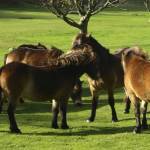Effect of Diet on Insulin Resistance Studied

Diagnosis of insulin sensitivity in horses is on the upswing, and for that reason identifying ways to manage insulin resistance is becoming more important. Though off-label use of metformin is one treatment strategy, it is not known whether the drug actually alters the course of the disease. Therefore, nutritional management of insulin-resistant horses has been investigated.
Researchers at Charles Sturt University, New South Wales, Australia, hypothesized that a base diet of oat hay would improve insulin sensitivity compared to a diet that would produce a more marked insulin response due to the addition of glucose. Diet 1 consisted of oat hay fed at 2% of BW and 400 g/d rice bran, and Diet 2 was the same as Diet 1 except for the addition of 1.5 g/kg BW glucose. Eight pony mares were used in the cross-over study. All were determined to be insulin resistant based on body condition score (between 7 and 9), cresty neck score (> 3), and results of a combined glucose-insulin test. Mares had no history of Cushing’s disease or laminitis.
Mares were randomly assigned to one of two treatment sequences. Both periods lasted 31 days with a frequently sampled intravenous glucose tolerance test (FSIGTT) conducted on days 0 and 32 on all ponies. The FSIGTT consisted of an intravenous glucose bolus (300 mg/kg BW) followed 20 minutes later by insulin (20 mU/kg BW). Plasma concentrations of glucose and insulin were then determined from the FSIGTT. An oral glucose tolerance test (OGTT: 0.75 g glucose/kg BW in 400 g rice bran) was performed on overnight-fasted ponies on days 1 and 31 with both groups in treatment period 2. Plasma glucose and insulin concentrations were measured in samples taken every 15 minutes for three hours.
All ponies remained clinically healthy throughout the study with no significant change in body weight or cresty neck score. Neither diet affected insulin sensitivity. Researchers theorize that the ponies could have adapted their glucose/insulin responses early in the study period.
This study was presented at the 2011 Equine Science Society Symposium in Murfreesboro, Tenn. The proceedings from this symposium are available from the Journal of Equine Veterinary Science.








